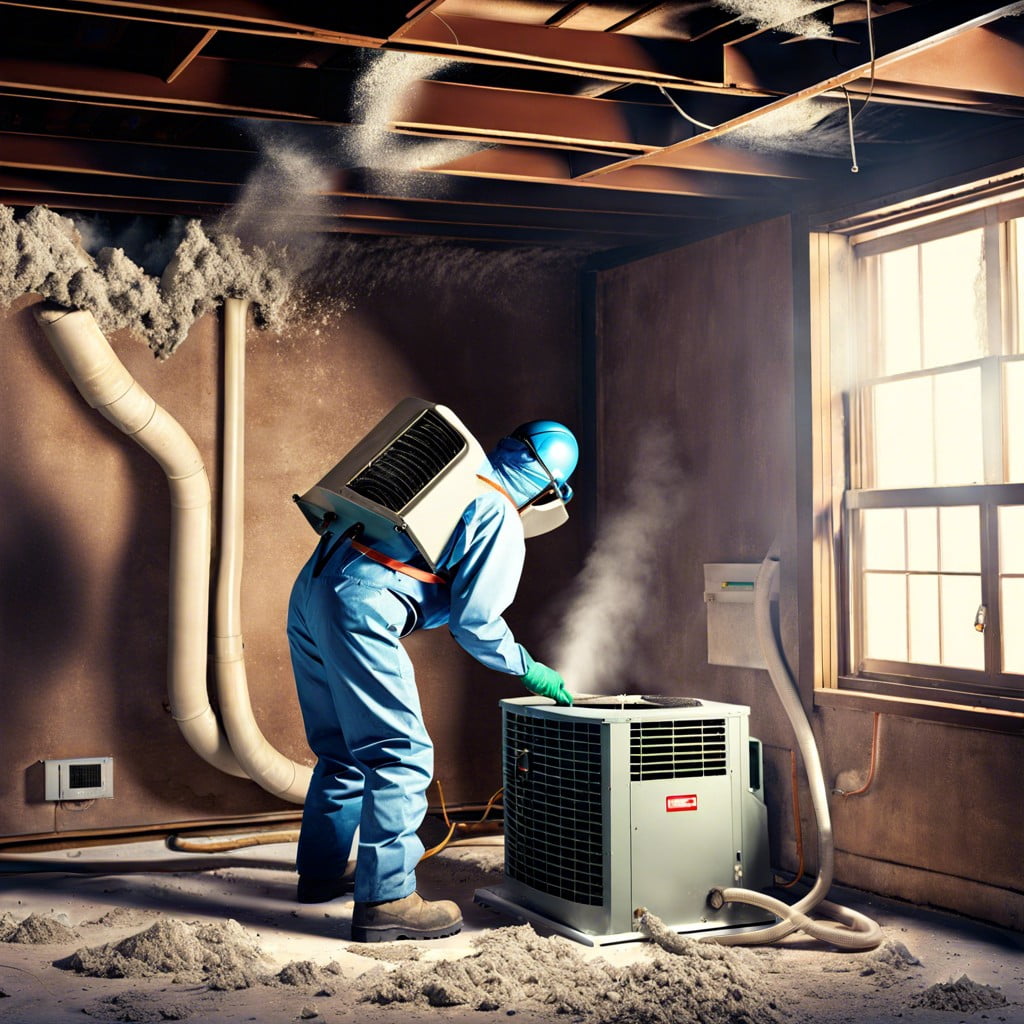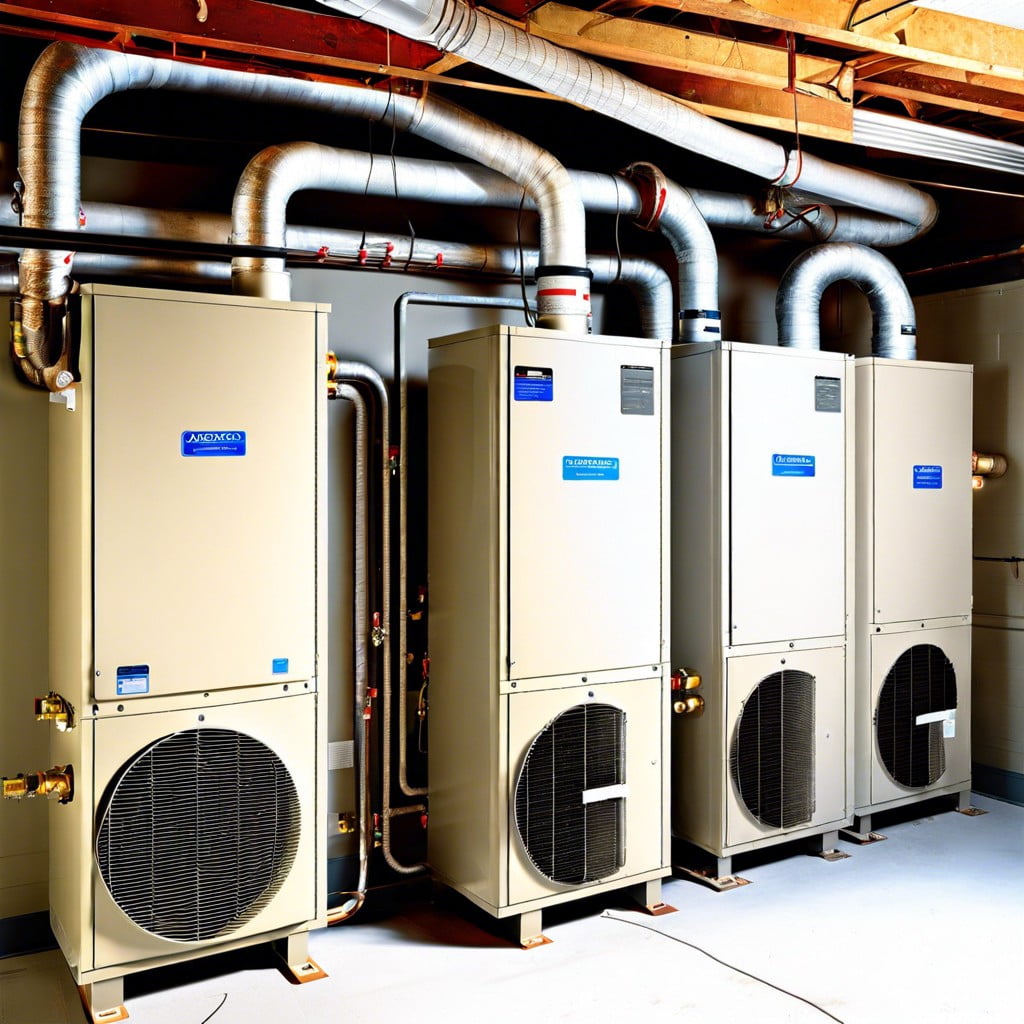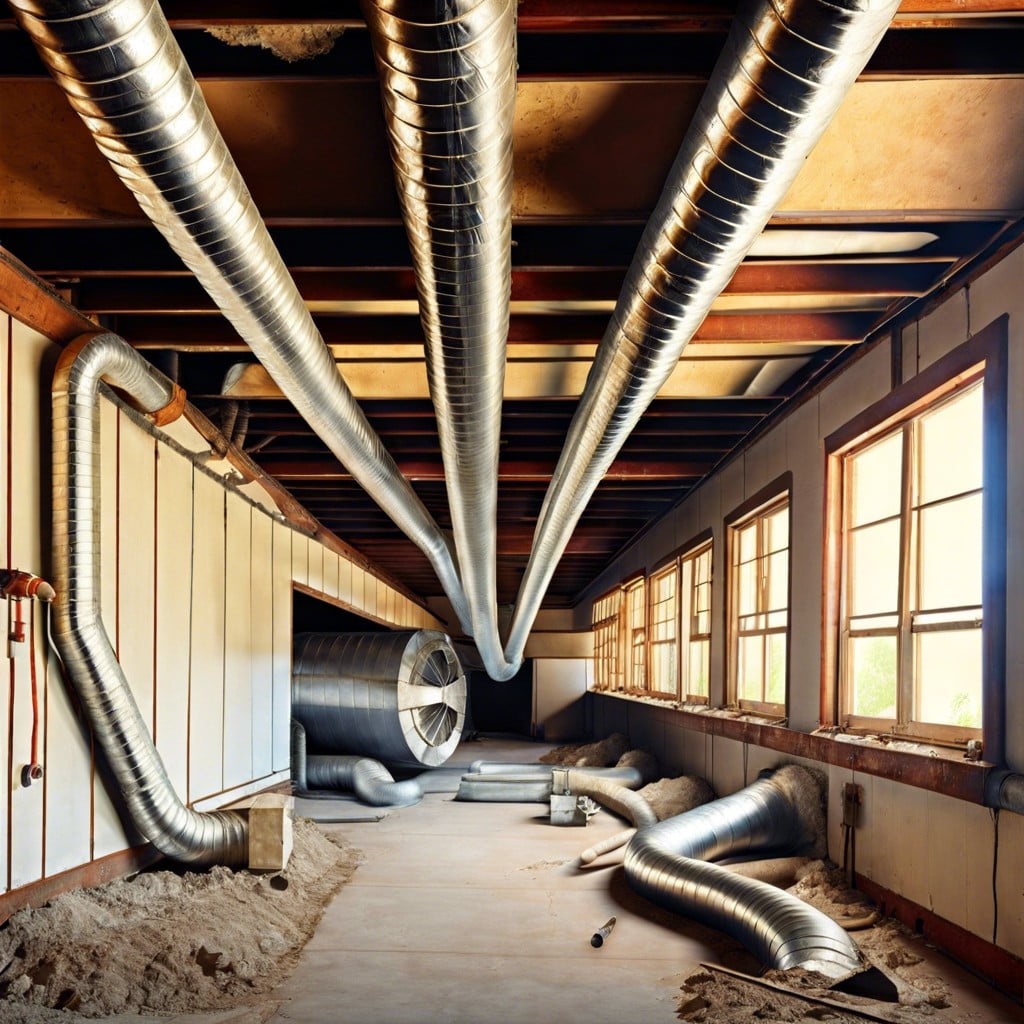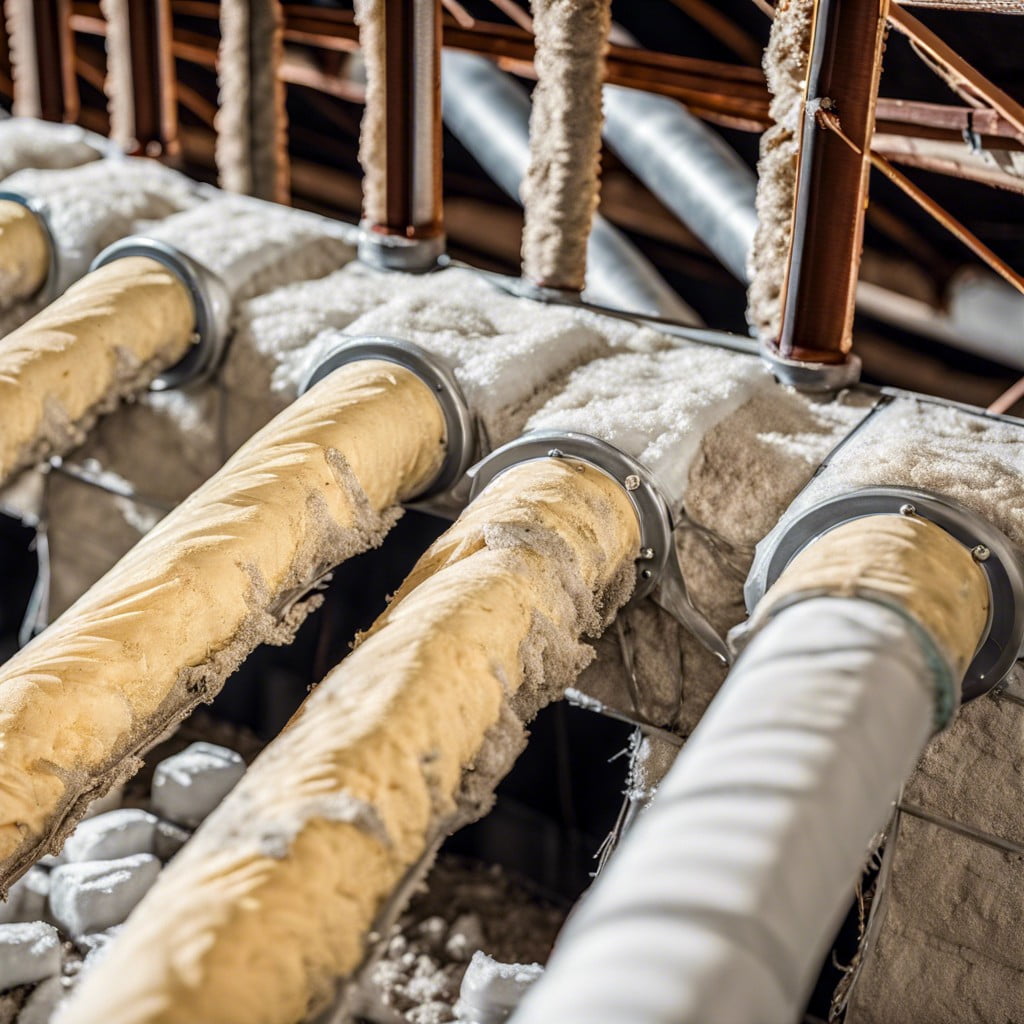Last updated on
Knowing how to identify and handle asbestos in your HVAC system is critically important because it can greatly affect the air quality in your home and your overall health.
Key takeaways:
- Asbestos fibers can cause serious respiratory conditions.
- Identify asbestos in HVAC systems by inspecting insulation, sealants, and textural cues.
- Asbestos in heating ducts can pose a risk if disturbed.
- Asbestos-containing insulation may look like white or gray corrugated material.
- HVAC technicians and maintenance workers are at high risk of exposure.
The Dangers of Asbestos

Understanding the perils associated with asbestos is paramount to safeguarding your health. This fibrous mineral, once a popular choice due to its heat resistance and insulative properties, is now recognized as a hazard when its fibers become airborne and are inhaled.
Long-term exposure is linked to serious respiratory conditions, including asbestosis, lung cancer, and mesothelioma—a rare form of cancer that primarily affects the lining of the lungs or abdomen. These ailments often have a long latency period, meaning symptoms may not present until years after exposure.
Moreover, disturbed asbestos within old HVAC systems can pose a risk not just to occupants but also to technicians if not properly handled. The key is awareness and ensuring that any asbestos-containing materials are identified and professionally managed to mitigate any potential health concerns. It’s not just about avoiding immediate issues—taking steps today is a proactive measure for long-term wellness.
How to Locate Asbestos in Your HVAC System

Identifying asbestos in your HVAC system requires a keen eye and knowledge of where it might be found.
- Start by examining the age of your home: Older structures built before the 1980s are more likely to contain asbestos materials.
- Check for insulation: Look for white or gray corrugated material around pipes, furnaces, and air ducts; this could be asbestos insulation.
- Tape and other sealants: Be on the lookout for fibrous tapes or sealants used around HVAC duct joins, as these often contained asbestos for fireproofing and insulation.
- Access panels: Asbestos might be present in panel lining within HVAC systems or as part of the ductwork itself.
- Textural cues: Materials that appear crumbly, fuzzy, or have a mud-like texture may contain asbestos and require careful handling.
It’s crucial to note that only a professional can confirm the presence of asbestos through laboratory testing. If you suspect asbestos, do not attempt to remove or disturb it. Contact an accredited asbestos abatement professional to safely assess and handle the situation.
Asbestos in Heating Ducts Explained

Understanding the presence of asbestos in heating ducts is crucial due to its past prevalence in building materials.
In the mid-20th century, asbestos was frequently used for its heat resistance and insulating properties.
It could be found in various components of HVAC systems, particularly the insulation surrounding ductwork.
Over time, this material can deteriorate, becoming friable, or crumbly, allowing fibers to become airborne and pose health risks.
In homes built before 1980, it’s not uncommon to find this hazardous material still in place.
If undisturbed and in good condition, the risk may be minimal, but it’s essential to recognize that any renovations or damage can release fibers into the air.
Professional assessment and removal, when necessary, are key steps in ensuring the safety of your living environment.
Asbestos in HVAC Insulation

Historically, asbestos was a common component in HVAC insulation due to its heat resistance and insulating properties. Primarily found in insulation materials surrounding pipes, boilers, and ductwork, asbestos-containing insulation can pose a significant health risk if disturbed.
Point 1: Identifying Asbestos Insulation
Asbestos-containing insulation may look like a white or gray corrugated paper, a cementitious board, or loose-fill material. It’s important to note that modern insulation should be asbestos-free, but buildings constructed before the 1980s might still contain these older materials.
Point 2: Disturbance and Risk
When left undisturbed and in good condition, asbestos insulation isn’t typically a health hazard. The danger arises when the material is damaged, causing fibers to become airborne. Renovation, demolition, or improper handling can lead to exposure.
Point 3: Professional Assessment and Removal
Due to the risk of exposure, it’s essential to have suspected asbestos insulation evaluated by a certified asbestos professional. They can conduct tests and properly remove or encapsulate the material if necessary, ensuring the safety of building occupants.
Engage professionals for both the survey and the removal process to ensure adherence to safety standards and regulations. Remember, handling asbestos is not a DIY project.
Who Was Exposed to Asbestos in Heating Ducts?
HVAC technicians and maintenance workers historically faced the highest risk due to direct contact during installation, repairs, and maintenance of heating systems. Construction workers and demolition crews who worked on buildings with older HVAC systems also experienced significant exposure when disrupting asbestos-containing materials.
Homeowners performing DIY renovations could inadvertently disturb asbestos if their homes have original heating ductwork from the era when asbestos was commonly used. Additionally, family members of these workers could have been exposed to asbestos fibers brought home on clothing or work gear.
Health Risks of Asbestos in Heating Ducts
Asbestos fibers, when disturbed, can become airborne and pose significant health challenges. Long-term inhalation of these fibers can lead to serious conditions, including:
- Asbestosis: A chronic lung disease causing scarring of lung tissue, which impedes breathing.
- Lung Cancer: An increased risk associated with the inhalation of asbestos fibers, especially for smokers.
- Mesothelioma: A rare form of cancer primarily affecting the lining of the lungs or abdomen, strongly linked to asbestos exposure.
These conditions often develop years after exposure, making early detection difficult. Regular health check-ups and monitoring air quality in environments with potential asbestos are critical for prevention and early intervention.
How Are HVAC Mechanics Exposed to Asbestos?
HVAC mechanics’ potential exposure to asbestos occurs during the installation, repair, or maintenance of heating, ventilation, and air conditioning systems, particularly in older buildings. When working on ductwork, insulation, or old heating units that contain asbestos-materials, asbestos fibers may be released into the air. Disturbance of asbestos-containing materials can occur when:
- Cutting or drilling into asbestos insulation to fit new components.
- Replacing old asbestos-lined duct connectors with new pieces.
- Sanding or scraping off old asbestos-containing tape used for sealing joints.
- Removing entire segments of ductwork wrapped in asbestos paper.
- Sweeping up debris that may contain asbestos dust in older installations.
Precautions such as wearing protective gear and using proper asbestos abatement techniques are essential to minimize the inhalation of these fibers, which pose health risks.
Asbestos Products Associated With HVAC Mechanics
HVAC mechanics have historically encountered various products containing asbestos, primarily due to its heat-resistant properties. Among these, insulation materials are common offenders. These can range from the insulation surrounding pipes and boilers to the ductwork integral to a building’s heating and cooling systems.
Gaskets and sealants also often contained asbestos, used to prevent leaks and maintain temperature control within HVAC systems. Additionally, mechanics may come across older equipment like furnace doors and heat shields, which were manufactured with asbestos-containing materials to withstand high temperatures.
It’s crucial for current professionals in the field to stay informed about the presence of these materials to ensure safety and compliance with modern regulations.
Manufacturers Who Made Products HVAC Mechanics Used
Several prominent manufacturers historically supplied HVAC mechanics with products containing asbestos, which was prized for its fire-resistant and insulating properties.
Companies like Johns Manville, Owens Corning Fiberglass, and W.R. Grace produced tapes, insulating materials, and other products that were regularly used in heating and cooling systems.
As awareness of asbestos hazards grew, many of these companies faced litigation and subsequently developed asbestos-free alternatives.
Today, it’s critical for mechanics and homeowners alike to be aware of the origins and potential asbestos content in older HVAC components to ensure proper handling and abatement procedures are followed.
HVAC Mechanics and Mesothelioma
HVAC mechanics historically faced hazardous conditions that, unbeknownst to many at the time, could lead to serious health issues such as mesothelioma. This aggressive cancer primarily targets the lining of the lungs and is directly linked to asbestos exposure.
- Mesothelioma typically develops after inhaling asbestos fibers that become lodged in the pleura, the thin tissue surrounding the lungs.
- Due to the latency period of the disease, symptoms may not appear until 20 to 50 years after the initial exposure.
- HVAC mechanics might have encountered asbestos while repairing older systems, where asbestos-containing materials were commonly used for insulation.
- Regular maintenance, repair, or removal of these systems could disturb asbestos, releasing fibers into the air.
- Current safety regulations require proper protective gear and procedures when handling suspected asbestos-containing materials to reduce the risk of mesothelioma and other asbestos-related diseases.
Understanding these critical points can help HVAC mechanics appreciate the importance of safety measures and the risks of past asbestos exposure.
Legal Options for HVAC Mechanics Exposed to Asbestos
HVAC mechanics previously exposed to asbestos may have several legal avenues to explore:
1. Workers’ Compensation Claims: Eligible workers can file a claim for benefits through their employer’s workers’ compensation insurance. These benefits can help cover medical expenses and lost wages.
2. Personal Injury Lawsuits: If exposure can be linked to negligence on the part of the asbestos product manufacturers, mechanics can file a lawsuit seeking compensation for their injuries.
3. Asbestos Trust Funds: Many companies that manufactured asbestos-containing products have established trust funds to compensate workers affected by their products. Qualified individuals can file a claim against these funds.
4. Veterans’ Benefits: For HVAC mechanics exposed to asbestos during military service, the Department of Veterans Affairs offers benefits.
5. Legal Assistance: Because these cases can be complex, seeking advice from an attorney experienced in asbestos-related claims is essential for navigating the legal process effectively.
Types of Asbestos Ductwork Connectors
Navigating the world of asbestos ductwork connectors can be a bit daunting. Understanding the varieties helps in identifying potential asbestos risks in your home or building.
Asbestos duct connectors came in several forms, primarily used to join sections of ductwork or to join ducts to HVAC units. Here are the most prevalent types:
- 1. Fibrous Tape Connectors: These are band-like materials wrapped around duct joints, providing a secure and airtight seal.
- 2. Flexible Duct Connectors: Made from fabric or rubber compounds containing asbestos, these connectors allowed for some movement due to thermal expansion or vibration without creating air leaks.
- 3. Canvas Connectors: Often found in older homes, these connectors look like thick, woven cloth and were used at points where ductwork meets the furnace or air conditioner unit.
- 4. Cementitious Compound Connectors: This type of connector involved a paste-like asbestos-containing material that solidified over time to ensure a rigid, heat-resistant joint.
Spotting these types of connectors during renovations or repairs is crucial for proper asbestos handling and abatement to ensure a safe living or working environment.
Diseases Asbestos Ductwork Connectors Can Cause
Exposure to asbestos fibers, particularly when they are disturbed and become airborne, can lead to serious health conditions. These can develop years after initial exposure:
- Mesothelioma: A rare, aggressive cancer typically affecting the lining of the lungs (pleural mesothelioma) or the abdomen (peritoneal mesothelioma).
- Lung Cancer: More common among people with significant exposure to asbestos.
- Asbestosis: A chronic lung disease characterized by long-term breathing complications and lung tissue scarring.
- Pleural Thickening: Fibrinous tissue develops on the lung’s outer lining, which can compress the lung and cause shortness of breath.
It is important to note that these diseases may not manifest until decades after exposure. Therefore, preventive measures and early detection are paramount for individuals who believe they may have been exposed to asbestos through ductwork connectors or any other means. Always consult with a healthcare professional if you suspect asbestos-related health issues.
Abatement and History of Asbestos Ductwork Connectors & Flexible Connectors
As the use of asbestos was prevalent prior to the 1980s, many HVAC systems installed during or before this period may contain asbestos ductwork connectors or flexible connectors. These components were favored for their fire-resistant and insulating qualities. However, the discovery of the serious health risks posed by asbestos fibers led to strict regulations on its use and the safe removal, known as abatement, of existing asbestos materials.
In terms of abatement, professionals follow established procedures to dismantle and dispose of the hazardous materials without releasing fibers into the air. This process typically involves sealing the affected area, using HEPA filtration, and carefully wetting the asbestos materials to prevent airborne particles. Once removed, the waste is securely bagged and transported to designated facilities for disposal.
If your home dates back to the era when asbestos was commonly used, it’s essential to have a professional inspection before undertaking any HVAC maintenance or renovations. Only certified asbestos abatement contractors are equipped to handle and safely remove these dangerous materials. Remember, undisturbed and intact asbestos may not pose an immediate risk, but it’s always best to consult an expert when dealing with any suspected asbestos in your home.
Asbestos Paper Wrap or Tape Used to Seal or Insulate Heating Ducts
Asbestos paper wrap and tape were commonly applied to seal joints and seams or insulate sections in heating duct systems. This heat-resistant material benefitted from asbestos fibers’ properties, which include excellent insulation against heat and resistance to fire.
However, over time, wear and tear or renovations can disturb these materials, releasing asbestos fibers into the air. Since the fibers are microscopic and can easily be inhaled, they pose serious health risks, particularly if the ductwork is within residential or commercial buildings where air circulation can spread the fibers throughout.
When asbestos-containing materials are intact and undisturbed, they are less likely to create a health hazard. Disturbance or damage to these materials, however, necessitates professional attention. Specialized abatement procedures must be employed to safely remove or encapsulate asbestos to prevent exposure.
It is crucial to avoid handling or disturbing suspected asbestos-containing materials. Instead, seek out the services of certified asbestos abatement professionals who follow strict regulatory guidelines to mitigate risk and ensure that the fibers do not become airborne during removal or repairs.
Regular inspections of older heating systems by a trained eye can help detect any potential asbestos issues before they pose a threat to indoor air quality.
Safety Measures for Handling and Maintaining Ductwork Wrapped in Asbestos
Prioritize professional assessment before beginning any work on your HVAC system to determine if asbestos is present. If so, it is crucial to refrain from disturbing the asbestos-containing materials—disturbance increases the risk of fiber release and exposure.
Wear appropriate personal protective equipment (PPE), including disposable coveralls, gloves, and a respirator with a HEPA filter, when dealing with asbestos-containing ductwork. This prevents inhalation of fibers and limits contamination of clothing.
Seal the work area with plastic sheeting and use wet cleaning methods rather than dry dusting or sweeping to minimize airborne asbestos fibres. Never use a standard vacuum as it can spread fibers further.
Place asbestos waste in labeled, leak-tight containers designed for hazardous materials. Ensure proper disposal according to local regulations, as asbestos waste requires special handling.
Stress on regular maintenance checks by qualified professionals to keep the system in good repair, reducing the need for handling and thus limiting exposure.
If asbestos abatement is necessary, hire licensed professionals. They have the expertise and equipment to safely remove or encapsulate the asbestos-containing materials without risking personal health or cross-contamination in your home.
Health Effects of Asbestos Duct Exposure
Exposure to asbestos fibers from deteriorating ductwork can lead to serious health issues. When inhaled, these microscopic fibers can become lodged in the lungs, causing inflammation and scarring. Over time, this damage can result in a range of respiratory ailments.
The most concerning are:
- Asbestosis: A chronic lung condition characterized by shortness of breath and a persistent cough, often leading to more severe lung impairments.
- Lung Cancer: Asbestos exposure significantly increases the risk of developing lung cancer, with symptoms that may not appear until many years later.
- Mesothelioma: A rare and aggressive cancer that affects the lining of the lungs, chest cavity, or abdominal cavity. Its direct correlation with asbestos exposure makes it a primary concern for those with prolonged contact.
- Pleural Effusions: Accumulation of fluid between the layers of tissue lining the lungs and chest cavity, often causing severe discomfort and breathing issues.
It’s vital to minimize asbestos exposure and consult health professionals if any symptoms arise, especially if prior asbestos exposure in the HVAC system is suspected. Regular maintenance and professional inspections can prevent the release of asbestos fibers into the air.
Companies With a History of Exposing Workers to Asbestos-Wrapped Ducts
Many HVAC companies used asbestos in their products until the late 1970s due to its fire-resistant and insulating properties. Workers handling installation, repair, or maintenance may have been exposed to asbestos fibers during these procedures. It’s important to note that inhalation of these fibers can lead to serious health concerns, including mesothelioma.
Key takeaways regarding historical exposure:
- Asbestos exposure was prevalent in HVAC installations prior to the 1980s.
- Companies such as Johns Manville and CertainTeed Corporation are among those that manufactured asbestos-containing materials used in ductwork.
- Workers involved in the production or servicing of these ducts faced a high risk of exposure.
- Asbestos fibers could become airborne during cutting or replacing of insulation.
- HVAC technicians and other tradespeople may still encounter old asbestos-wrapped ducts in buildings constructed before asbestos bans and regulations.
Awareness of the potential risks and understanding the historical use of asbestos in HVAC systems are vital for both professional and public health.
Who Is At Risk for Heating Duct Asbestos Exposure?
Individuals who live in older homes constructed before the 1980s may be susceptible to asbestos exposure, as heating duct insulation from that era often contained asbestos. HVAC professionals conducting repairs, maintenance, or installation in these settings face a heightened risk, particularly if they disturb aged ductwork and insulation.
Construction workers involved in the renovation or demolition of old buildings should take caution, as should homeowners tackling DIY projects that involve older heating systems. Family members of these workers can also be at risk through secondary exposure, as asbestos fibers can cling to clothing and be inadvertently brought home.
It’s essential for anyone who suspects the presence of asbestos to seek professional assessment and removal to mitigate risks.
Mesothelioma and Other Asbestos-Related Diseases
Asbestos exposure is a serious concern due to the potential for developing severe health conditions. Among these, mesothelioma, a rare cancer affecting the lining of the lungs, stands out for its direct link to asbestos fibers. Inhalation or ingestion of these minuscule fibers can lead to their lodging in organ linings, causing cellular damage over time.
In addition to mesothelioma, individuals exposed to asbestos may face other health risks such as asbestosis, a chronic lung disease characterized by lung tissue scarring, which can result in severe breathing difficulties. Lung cancer is another considerable risk, with asbestos exposure significantly increasing the likelihood of developing this disease.
Lastly, pleural plaques and pleural effusions are less known but equally concerning conditions. Pleural plaques involve the thickening of the lung lining, whereas pleural effusions are characterized by excess fluid between lung layers, both often signaling past asbestos exposure.
Despite the latency period of these diseases, which can span decades, early detection remains crucial for the best possible prognosis. Awareness and education on potential exposure sources and ensuing symptoms are critical for individuals at risk.
FAQ
How serious is one time asbestos exposure?
While a single exposure to asbestos may potentially lead to diseases like mesothelioma, the risk is typically significantly lower than that associated with long-term or repeated exposure.
At what temperature does asbestos burn?
Asbestos begins to burn at a temperature of approximately 1,600 degrees Fahrenheit.
What are the possible health implications of long-term asbestos exposure?
Long-term asbestos exposure can lead to serious health conditions such as lung cancer, mesothelioma, and asbestosis.
How can one safely remove asbestos from an HVAC system?
To safely remove asbestos from an HVAC system, it’s crucial to hire licensed professionals who are trained to handle and dispose of asbestos properly and follow safety protocols.
What measures should get put in place to prevent asbestos exposure during HVAC installation?
During HVAC installation, preventing asbestos exposure requires strict adherence to safety protocols, including using personal protective equipment, appropriately containing and disposing of any asbestos-containing materials, and ideally engaging asbestos removal professionals if pre-existing asbestos is present.
Recap




